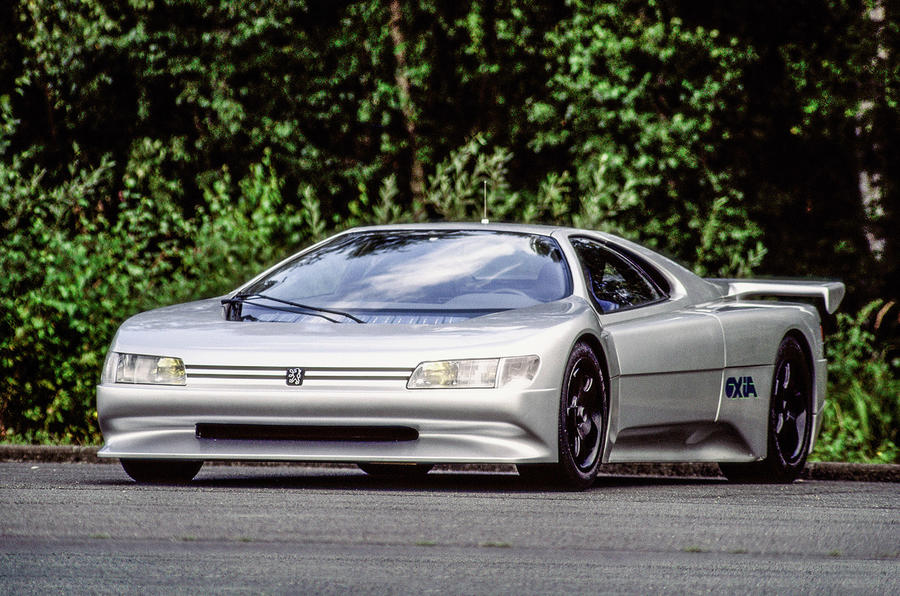From some angles, it is possible to just glimpse elements of the road-going 405 Coupé in the Oxia, which was Peugeot’s star attraction at the 1988 Paris motor show.
Named after the part of Mars that lies at longitude and latitude zero, the Oxia was a fully engineered design study “that ought to give Ferrari and Porsche some food for thought”, according to John Simister, Autocar’s chief features writer at the time.
The Oxia was more than a static design study, though. All four wheels drove and steered, a twin-turbo V6 gave 680bhp and the body and chassis were crafted from carbonfibre and Kevlar.
The Oxia weighed 1377kg, with the complex transmission – featuring an epicyclic centre differential giving a torque split of 25% front, 75% rear and incorporating a Ferguson viscous coupling, plus electronically controlled limited-slip differentials front and rear – and steering accounting for a lot of that. Suspension was by double wishbones all round, with each of the gas-filled dampers surrounded by a pair of concentric coil springs.
Beneath its sleek skin, the Oxia was a fusion of Group B rally car and Group C sportscar racer. Its engine was a 2849cc V6 with two Garrett T3 turbochargers, derived from the WM-Peugeot Le Mans cars that were famed for hitting 250mph on the Mulsanne Straight, and the four-wheel drive system was a refined version of the Peugeot 205 T16’s. The car delivered its blistering 680bhp at 8200rpm and an equally impressive 535lb ft at 4500rpm.
“The two occupants sit well forward behind a steeply raked windscreen, the bottom edge of which, barely 2ft from the Oxia’s nose, incorporates two rows of photoelectric cells to power the air-con fan when the engine isn’t running,” said Simister. “It’s a logical solution: more sun means more power means a faster fan means more airflow. Very Group C, too, are the way the rear wheels sit so far back, and the plethora of scoops and louvres.”
Simister watched the car in action around the Belchamps test track. “At low revs it sounds a little like a Porsche 911 or maybe a 959,” he wrote. “First gear is long, as you would expect from a car which could well be capable of 200mph with the right gearing – Peugeot will say only that it can top 180mph – but the Oxia pulls away cleanly and disappears from view around the banking.
“When it reappears, the engine is grunting lustily, the giant stainless steel silencer curbing some volume but making little impression on the bass and treble.
“Oxia is chased by a 405 Mi-16 as it hoves back into view, so it can’t be going any faster than about 135mph. Its rear wing would still be flat, for it doesn’t reach its 3deg raised position until 155mph. Once raised, though, it stays there for a full minute after the Oxia’s speed falls below this point.”






Join the debate
Add your comment
Oxia
That's very highly strung - more BHP-per-cyl than a Lancer Evo FQ400.
It is the only vehicle I have ever heard of that has a floppy drive. Wowsers.
@TheSaintmobile: sorry can't understand your post - can you rephrase.
Regards
-Davina-
tech demo
it is not that hard for any car company to build a cost-no-object one-off technology demonstrator and stuff it with the highest end components available.
Putting it to serial production and selling at a reasonable price is a different story.
Polestar used to brag how their highly tuned T6 S60 (marginally) beat an M5 on the track. That's very nice but an M5 is what, 80k and they spent something like 300 on the volvo.
Cost price
What, do you think BMW only spent £80,000 on developing the M5? If Polestar were going to make 20,000 T6 S60s you think they would be £300,000 each? Yes of course one-offs cost a lot, but the price isn't why the Oxia wouldn't have caused Ferrari and Porsche food for thought. That's because they sell on the cachet of their history and their status as much as technology, and even a car equal to their models on merit would not be a serious threat to their sales if it were wearing a Peugeot badge.
V6 twin Turbo. Well enough